Technology Use Impact on Customer Satisfaction: A Business Review
VerifiedAdded on 2023/06/15
|21
|4542
|490
Literature Review
AI Summary
This literature review explores the impact of technology on customer satisfaction, particularly within the banking sector. It identifies the problem of lacking customer satisfaction despite increased technology use and analyzes the relationship between technology (independent variable) and customer satisfaction (dependent variable). The review discusses various technologies like internet banking, electronic payments, and information exchanges, and their effects on customer satisfaction, referencing theories such as the Unified Theory of Acceptance and Use of Technology (UTAUT) and the Disconfirmation Paradigm. It also addresses challenges like security breaches and the displacement of human roles, emphasizing the importance of balancing technological advancements with customer expectations to foster loyalty and retention. This document is available on Desklib, a platform offering a range of study tools and solved assignments for students.

Business Research Methodology
Use of technology on customer satisfaction
Use of technology on customer satisfaction
Paraphrase This Document
Need a fresh take? Get an instant paraphrase of this document with our AI Paraphraser
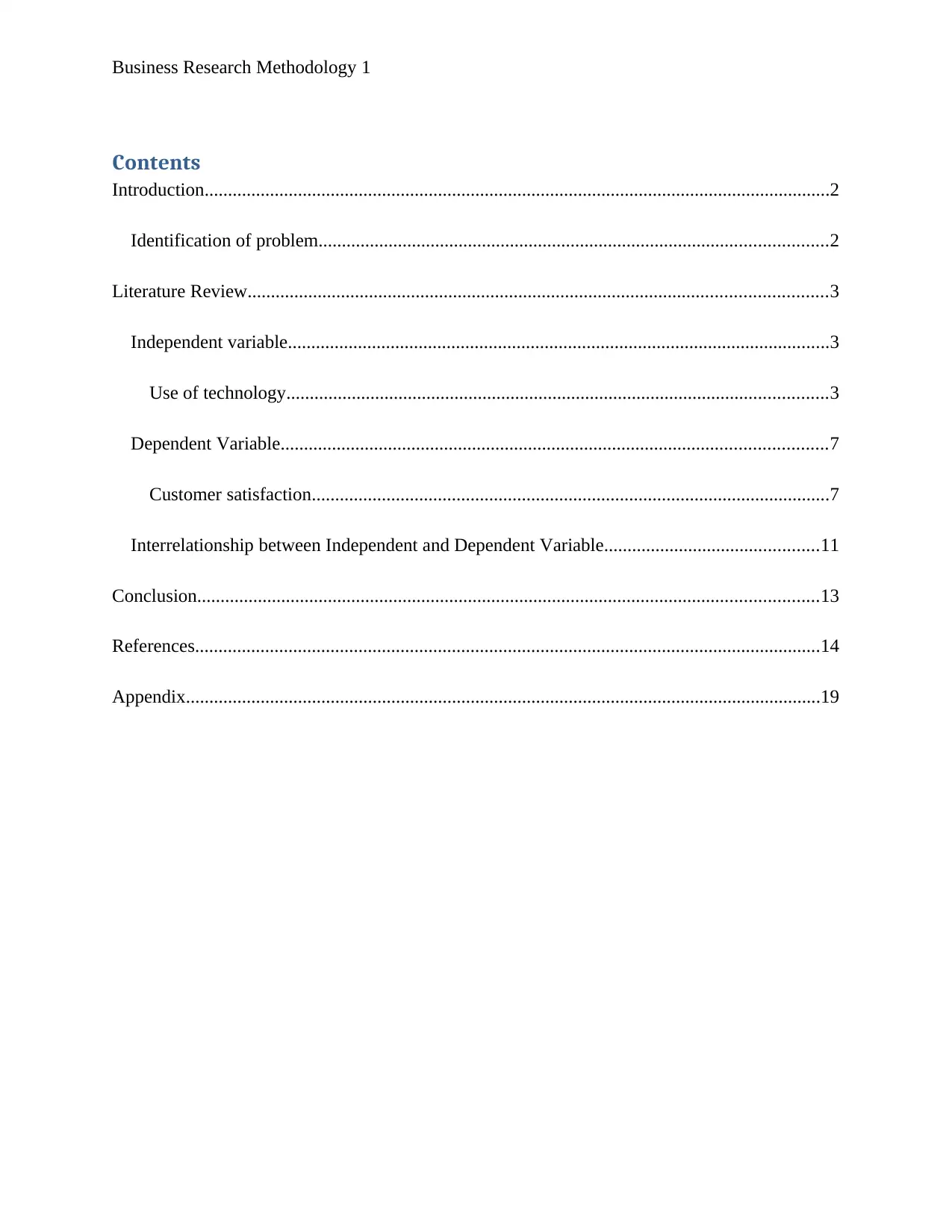
Business Research Methodology 1
Contents
Introduction......................................................................................................................................2
Identification of problem.............................................................................................................2
Literature Review............................................................................................................................3
Independent variable....................................................................................................................3
Use of technology....................................................................................................................3
Dependent Variable.....................................................................................................................7
Customer satisfaction...............................................................................................................7
Interrelationship between Independent and Dependent Variable..............................................11
Conclusion.....................................................................................................................................13
References......................................................................................................................................14
Appendix........................................................................................................................................19
Contents
Introduction......................................................................................................................................2
Identification of problem.............................................................................................................2
Literature Review............................................................................................................................3
Independent variable....................................................................................................................3
Use of technology....................................................................................................................3
Dependent Variable.....................................................................................................................7
Customer satisfaction...............................................................................................................7
Interrelationship between Independent and Dependent Variable..............................................11
Conclusion.....................................................................................................................................13
References......................................................................................................................................14
Appendix........................................................................................................................................19
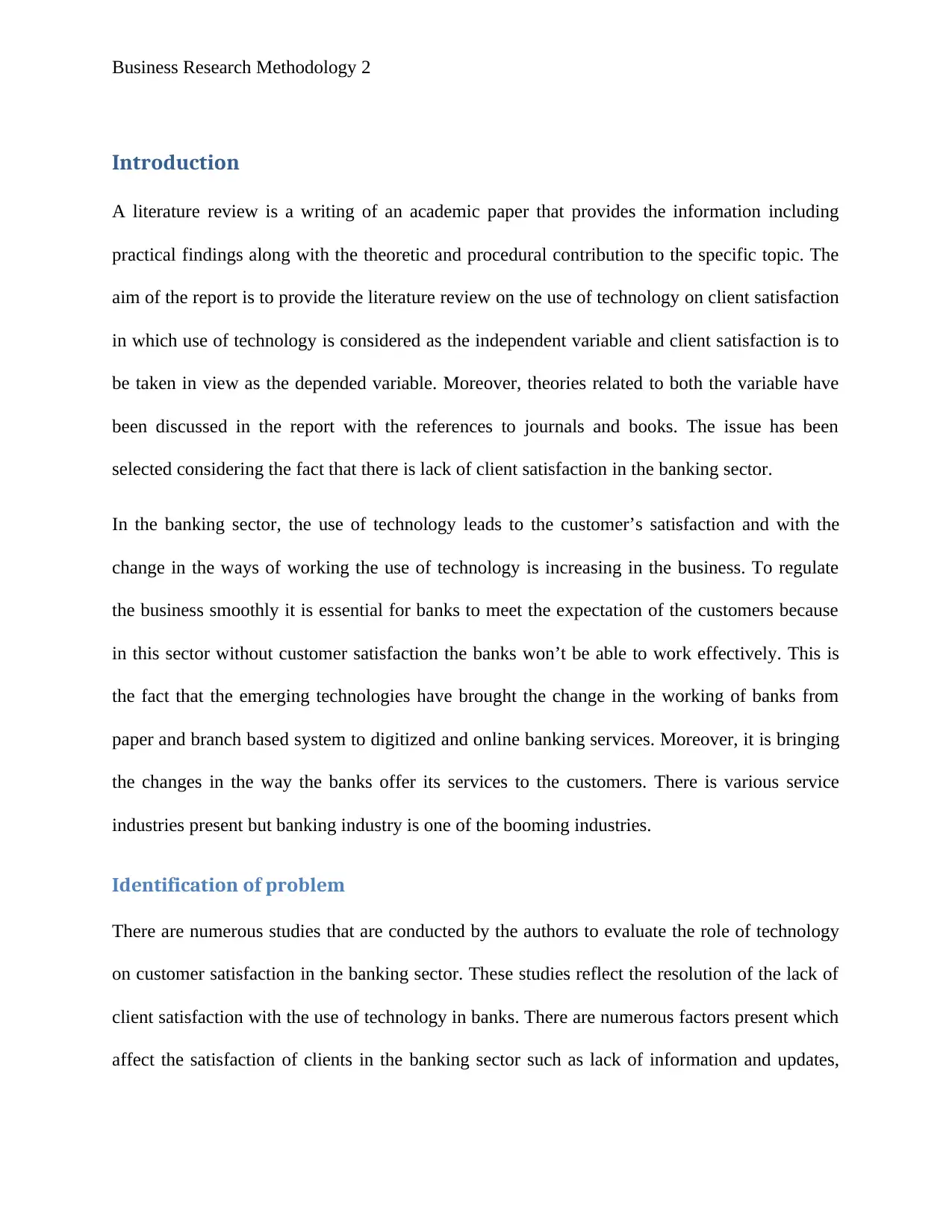
Business Research Methodology 2
Introduction
A literature review is a writing of an academic paper that provides the information including
practical findings along with the theoretic and procedural contribution to the specific topic. The
aim of the report is to provide the literature review on the use of technology on client satisfaction
in which use of technology is considered as the independent variable and client satisfaction is to
be taken in view as the depended variable. Moreover, theories related to both the variable have
been discussed in the report with the references to journals and books. The issue has been
selected considering the fact that there is lack of client satisfaction in the banking sector.
In the banking sector, the use of technology leads to the customer’s satisfaction and with the
change in the ways of working the use of technology is increasing in the business. To regulate
the business smoothly it is essential for banks to meet the expectation of the customers because
in this sector without customer satisfaction the banks won’t be able to work effectively. This is
the fact that the emerging technologies have brought the change in the working of banks from
paper and branch based system to digitized and online banking services. Moreover, it is bringing
the changes in the way the banks offer its services to the customers. There is various service
industries present but banking industry is one of the booming industries.
Identification of problem
There are numerous studies that are conducted by the authors to evaluate the role of technology
on customer satisfaction in the banking sector. These studies reflect the resolution of the lack of
client satisfaction with the use of technology in banks. There are numerous factors present which
affect the satisfaction of clients in the banking sector such as lack of information and updates,
Introduction
A literature review is a writing of an academic paper that provides the information including
practical findings along with the theoretic and procedural contribution to the specific topic. The
aim of the report is to provide the literature review on the use of technology on client satisfaction
in which use of technology is considered as the independent variable and client satisfaction is to
be taken in view as the depended variable. Moreover, theories related to both the variable have
been discussed in the report with the references to journals and books. The issue has been
selected considering the fact that there is lack of client satisfaction in the banking sector.
In the banking sector, the use of technology leads to the customer’s satisfaction and with the
change in the ways of working the use of technology is increasing in the business. To regulate
the business smoothly it is essential for banks to meet the expectation of the customers because
in this sector without customer satisfaction the banks won’t be able to work effectively. This is
the fact that the emerging technologies have brought the change in the working of banks from
paper and branch based system to digitized and online banking services. Moreover, it is bringing
the changes in the way the banks offer its services to the customers. There is various service
industries present but banking industry is one of the booming industries.
Identification of problem
There are numerous studies that are conducted by the authors to evaluate the role of technology
on customer satisfaction in the banking sector. These studies reflect the resolution of the lack of
client satisfaction with the use of technology in banks. There are numerous factors present which
affect the satisfaction of clients in the banking sector such as lack of information and updates,
⊘ This is a preview!⊘
Do you want full access?
Subscribe today to unlock all pages.

Trusted by 1+ million students worldwide
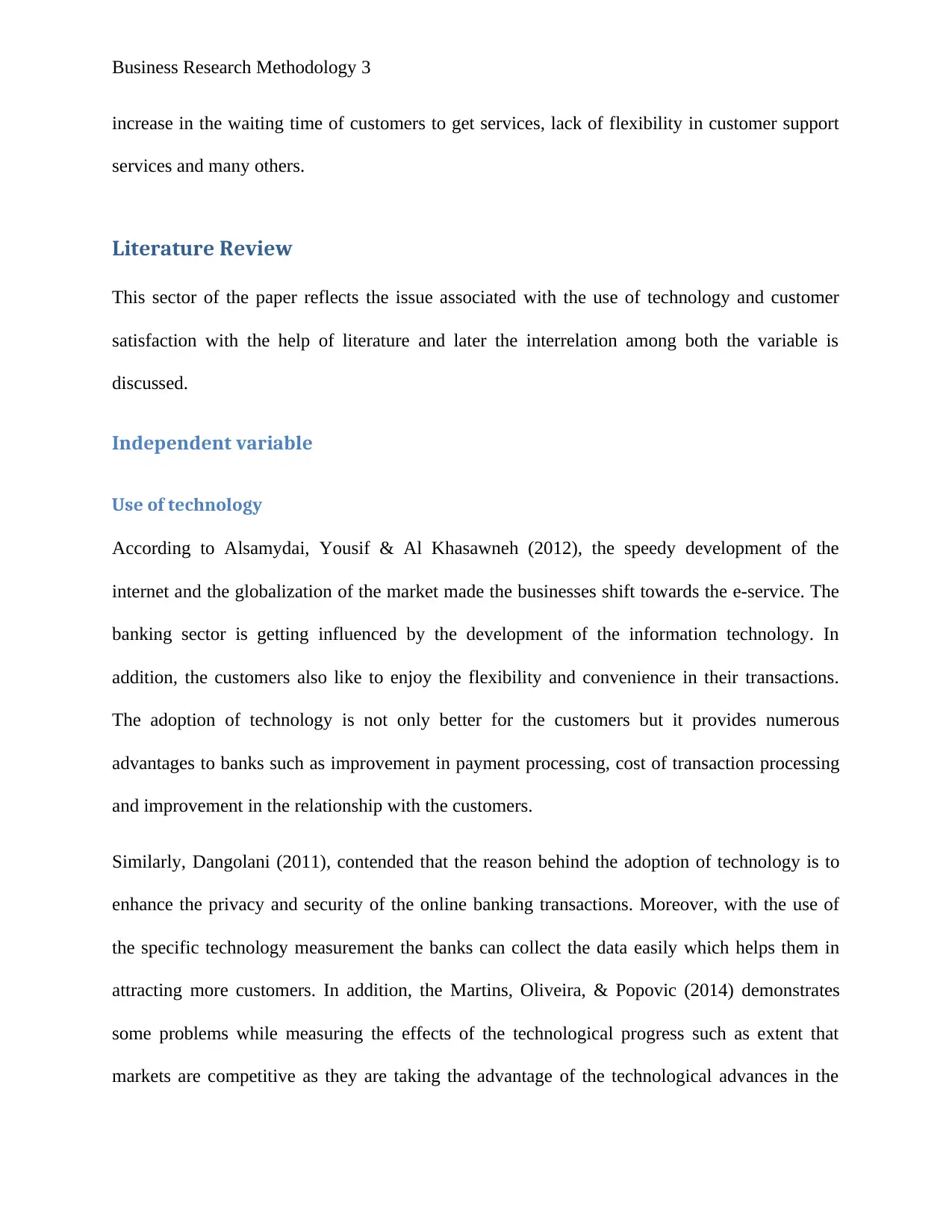
Business Research Methodology 3
increase in the waiting time of customers to get services, lack of flexibility in customer support
services and many others.
Literature Review
This sector of the paper reflects the issue associated with the use of technology and customer
satisfaction with the help of literature and later the interrelation among both the variable is
discussed.
Independent variable
Use of technology
According to Alsamydai, Yousif & Al Khasawneh (2012), the speedy development of the
internet and the globalization of the market made the businesses shift towards the e-service. The
banking sector is getting influenced by the development of the information technology. In
addition, the customers also like to enjoy the flexibility and convenience in their transactions.
The adoption of technology is not only better for the customers but it provides numerous
advantages to banks such as improvement in payment processing, cost of transaction processing
and improvement in the relationship with the customers.
Similarly, Dangolani (2011), contended that the reason behind the adoption of technology is to
enhance the privacy and security of the online banking transactions. Moreover, with the use of
the specific technology measurement the banks can collect the data easily which helps them in
attracting more customers. In addition, the Martins, Oliveira, & Popovic (2014) demonstrates
some problems while measuring the effects of the technological progress such as extent that
markets are competitive as they are taking the advantage of the technological advances in the
increase in the waiting time of customers to get services, lack of flexibility in customer support
services and many others.
Literature Review
This sector of the paper reflects the issue associated with the use of technology and customer
satisfaction with the help of literature and later the interrelation among both the variable is
discussed.
Independent variable
Use of technology
According to Alsamydai, Yousif & Al Khasawneh (2012), the speedy development of the
internet and the globalization of the market made the businesses shift towards the e-service. The
banking sector is getting influenced by the development of the information technology. In
addition, the customers also like to enjoy the flexibility and convenience in their transactions.
The adoption of technology is not only better for the customers but it provides numerous
advantages to banks such as improvement in payment processing, cost of transaction processing
and improvement in the relationship with the customers.
Similarly, Dangolani (2011), contended that the reason behind the adoption of technology is to
enhance the privacy and security of the online banking transactions. Moreover, with the use of
the specific technology measurement the banks can collect the data easily which helps them in
attracting more customers. In addition, the Martins, Oliveira, & Popovic (2014) demonstrates
some problems while measuring the effects of the technological progress such as extent that
markets are competitive as they are taking the advantage of the technological advances in the
Paraphrase This Document
Need a fresh take? Get an instant paraphrase of this document with our AI Paraphraser
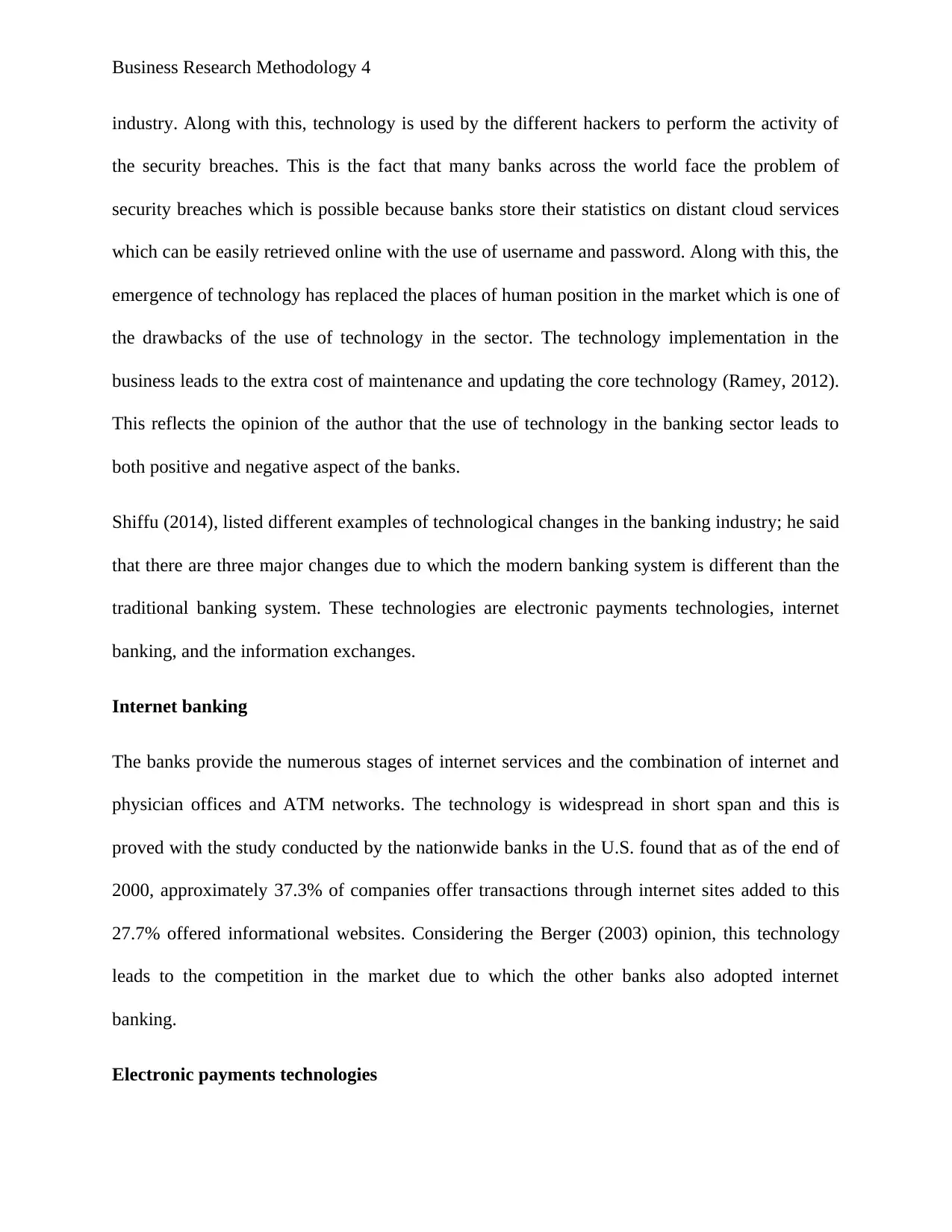
Business Research Methodology 4
industry. Along with this, technology is used by the different hackers to perform the activity of
the security breaches. This is the fact that many banks across the world face the problem of
security breaches which is possible because banks store their statistics on distant cloud services
which can be easily retrieved online with the use of username and password. Along with this, the
emergence of technology has replaced the places of human position in the market which is one of
the drawbacks of the use of technology in the sector. The technology implementation in the
business leads to the extra cost of maintenance and updating the core technology (Ramey, 2012).
This reflects the opinion of the author that the use of technology in the banking sector leads to
both positive and negative aspect of the banks.
Shiffu (2014), listed different examples of technological changes in the banking industry; he said
that there are three major changes due to which the modern banking system is different than the
traditional banking system. These technologies are electronic payments technologies, internet
banking, and the information exchanges.
Internet banking
The banks provide the numerous stages of internet services and the combination of internet and
physician offices and ATM networks. The technology is widespread in short span and this is
proved with the study conducted by the nationwide banks in the U.S. found that as of the end of
2000, approximately 37.3% of companies offer transactions through internet sites added to this
27.7% offered informational websites. Considering the Berger (2003) opinion, this technology
leads to the competition in the market due to which the other banks also adopted internet
banking.
Electronic payments technologies
industry. Along with this, technology is used by the different hackers to perform the activity of
the security breaches. This is the fact that many banks across the world face the problem of
security breaches which is possible because banks store their statistics on distant cloud services
which can be easily retrieved online with the use of username and password. Along with this, the
emergence of technology has replaced the places of human position in the market which is one of
the drawbacks of the use of technology in the sector. The technology implementation in the
business leads to the extra cost of maintenance and updating the core technology (Ramey, 2012).
This reflects the opinion of the author that the use of technology in the banking sector leads to
both positive and negative aspect of the banks.
Shiffu (2014), listed different examples of technological changes in the banking industry; he said
that there are three major changes due to which the modern banking system is different than the
traditional banking system. These technologies are electronic payments technologies, internet
banking, and the information exchanges.
Internet banking
The banks provide the numerous stages of internet services and the combination of internet and
physician offices and ATM networks. The technology is widespread in short span and this is
proved with the study conducted by the nationwide banks in the U.S. found that as of the end of
2000, approximately 37.3% of companies offer transactions through internet sites added to this
27.7% offered informational websites. Considering the Berger (2003) opinion, this technology
leads to the competition in the market due to which the other banks also adopted internet
banking.
Electronic payments technologies
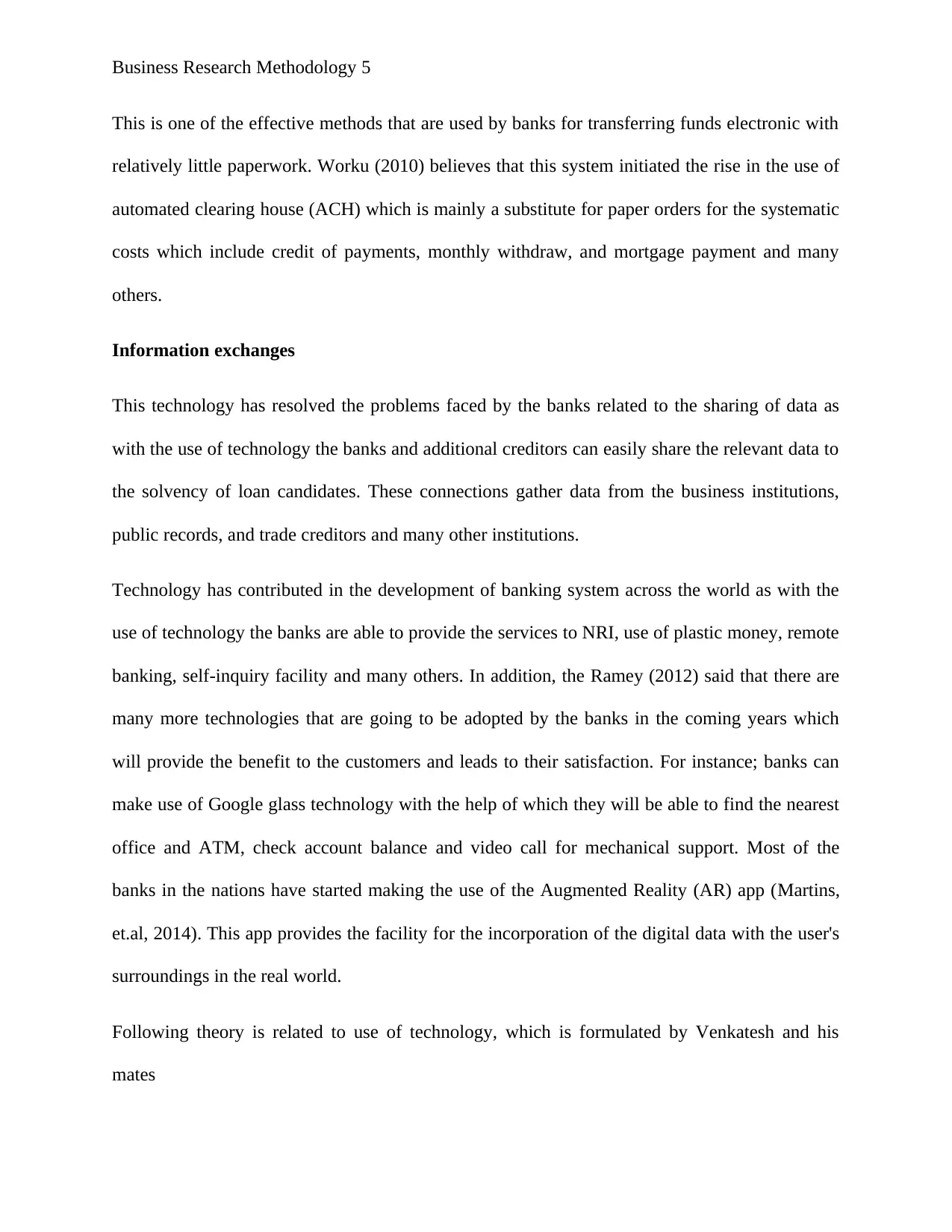
Business Research Methodology 5
This is one of the effective methods that are used by banks for transferring funds electronic with
relatively little paperwork. Worku (2010) believes that this system initiated the rise in the use of
automated clearing house (ACH) which is mainly a substitute for paper orders for the systematic
costs which include credit of payments, monthly withdraw, and mortgage payment and many
others.
Information exchanges
This technology has resolved the problems faced by the banks related to the sharing of data as
with the use of technology the banks and additional creditors can easily share the relevant data to
the solvency of loan candidates. These connections gather data from the business institutions,
public records, and trade creditors and many other institutions.
Technology has contributed in the development of banking system across the world as with the
use of technology the banks are able to provide the services to NRI, use of plastic money, remote
banking, self-inquiry facility and many others. In addition, the Ramey (2012) said that there are
many more technologies that are going to be adopted by the banks in the coming years which
will provide the benefit to the customers and leads to their satisfaction. For instance; banks can
make use of Google glass technology with the help of which they will be able to find the nearest
office and ATM, check account balance and video call for mechanical support. Most of the
banks in the nations have started making the use of the Augmented Reality (AR) app (Martins,
et.al, 2014). This app provides the facility for the incorporation of the digital data with the user's
surroundings in the real world.
Following theory is related to use of technology, which is formulated by Venkatesh and his
mates
This is one of the effective methods that are used by banks for transferring funds electronic with
relatively little paperwork. Worku (2010) believes that this system initiated the rise in the use of
automated clearing house (ACH) which is mainly a substitute for paper orders for the systematic
costs which include credit of payments, monthly withdraw, and mortgage payment and many
others.
Information exchanges
This technology has resolved the problems faced by the banks related to the sharing of data as
with the use of technology the banks and additional creditors can easily share the relevant data to
the solvency of loan candidates. These connections gather data from the business institutions,
public records, and trade creditors and many other institutions.
Technology has contributed in the development of banking system across the world as with the
use of technology the banks are able to provide the services to NRI, use of plastic money, remote
banking, self-inquiry facility and many others. In addition, the Ramey (2012) said that there are
many more technologies that are going to be adopted by the banks in the coming years which
will provide the benefit to the customers and leads to their satisfaction. For instance; banks can
make use of Google glass technology with the help of which they will be able to find the nearest
office and ATM, check account balance and video call for mechanical support. Most of the
banks in the nations have started making the use of the Augmented Reality (AR) app (Martins,
et.al, 2014). This app provides the facility for the incorporation of the digital data with the user's
surroundings in the real world.
Following theory is related to use of technology, which is formulated by Venkatesh and his
mates
⊘ This is a preview!⊘
Do you want full access?
Subscribe today to unlock all pages.

Trusted by 1+ million students worldwide
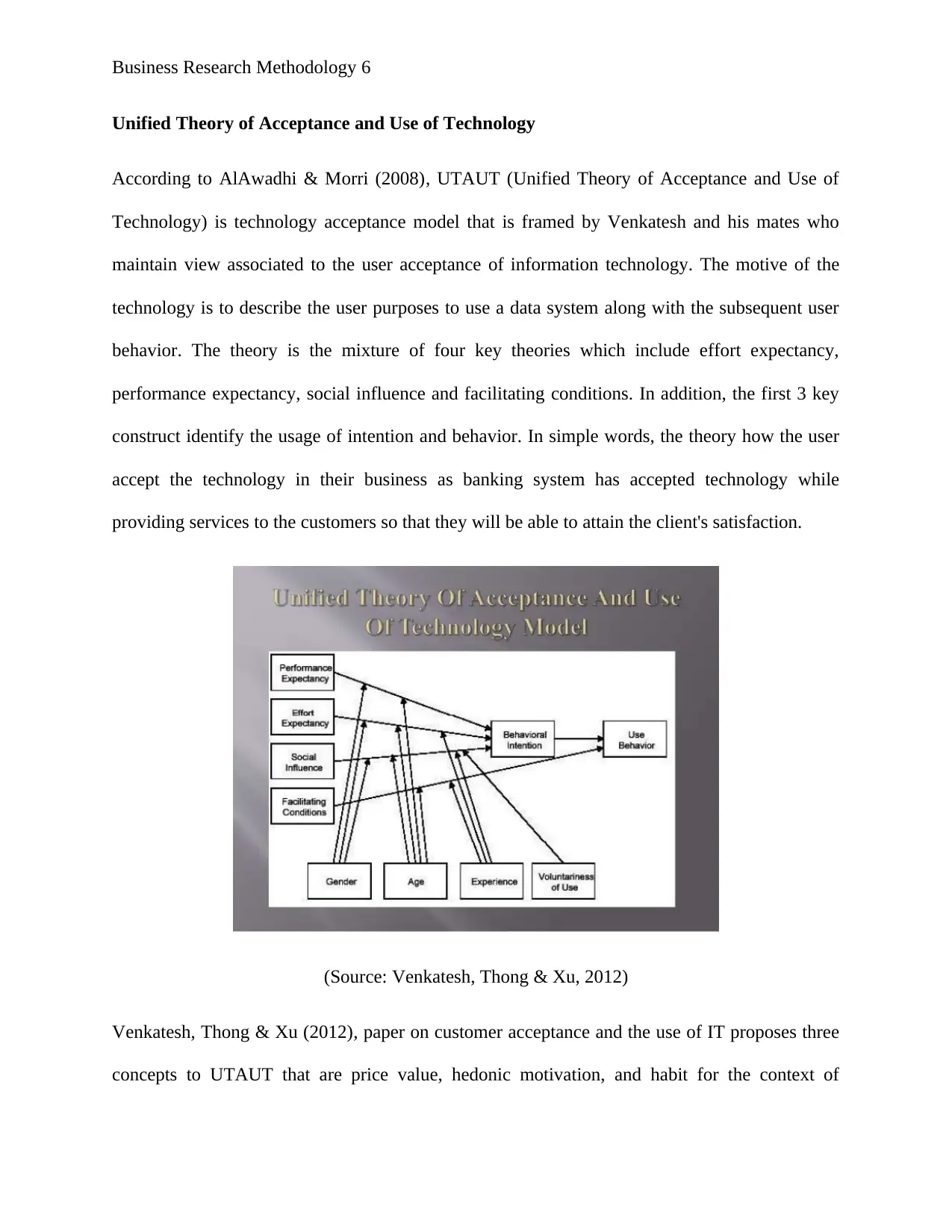
Business Research Methodology 6
Unified Theory of Acceptance and Use of Technology
According to AlAwadhi & Morri (2008), UTAUT (Unified Theory of Acceptance and Use of
Technology) is technology acceptance model that is framed by Venkatesh and his mates who
maintain view associated to the user acceptance of information technology. The motive of the
technology is to describe the user purposes to use a data system along with the subsequent user
behavior. The theory is the mixture of four key theories which include effort expectancy,
performance expectancy, social influence and facilitating conditions. In addition, the first 3 key
construct identify the usage of intention and behavior. In simple words, the theory how the user
accept the technology in their business as banking system has accepted technology while
providing services to the customers so that they will be able to attain the client's satisfaction.
(Source: Venkatesh, Thong & Xu, 2012)
Venkatesh, Thong & Xu (2012), paper on customer acceptance and the use of IT proposes three
concepts to UTAUT that are price value, hedonic motivation, and habit for the context of
Unified Theory of Acceptance and Use of Technology
According to AlAwadhi & Morri (2008), UTAUT (Unified Theory of Acceptance and Use of
Technology) is technology acceptance model that is framed by Venkatesh and his mates who
maintain view associated to the user acceptance of information technology. The motive of the
technology is to describe the user purposes to use a data system along with the subsequent user
behavior. The theory is the mixture of four key theories which include effort expectancy,
performance expectancy, social influence and facilitating conditions. In addition, the first 3 key
construct identify the usage of intention and behavior. In simple words, the theory how the user
accept the technology in their business as banking system has accepted technology while
providing services to the customers so that they will be able to attain the client's satisfaction.
(Source: Venkatesh, Thong & Xu, 2012)
Venkatesh, Thong & Xu (2012), paper on customer acceptance and the use of IT proposes three
concepts to UTAUT that are price value, hedonic motivation, and habit for the context of
Paraphrase This Document
Need a fresh take? Get an instant paraphrase of this document with our AI Paraphraser
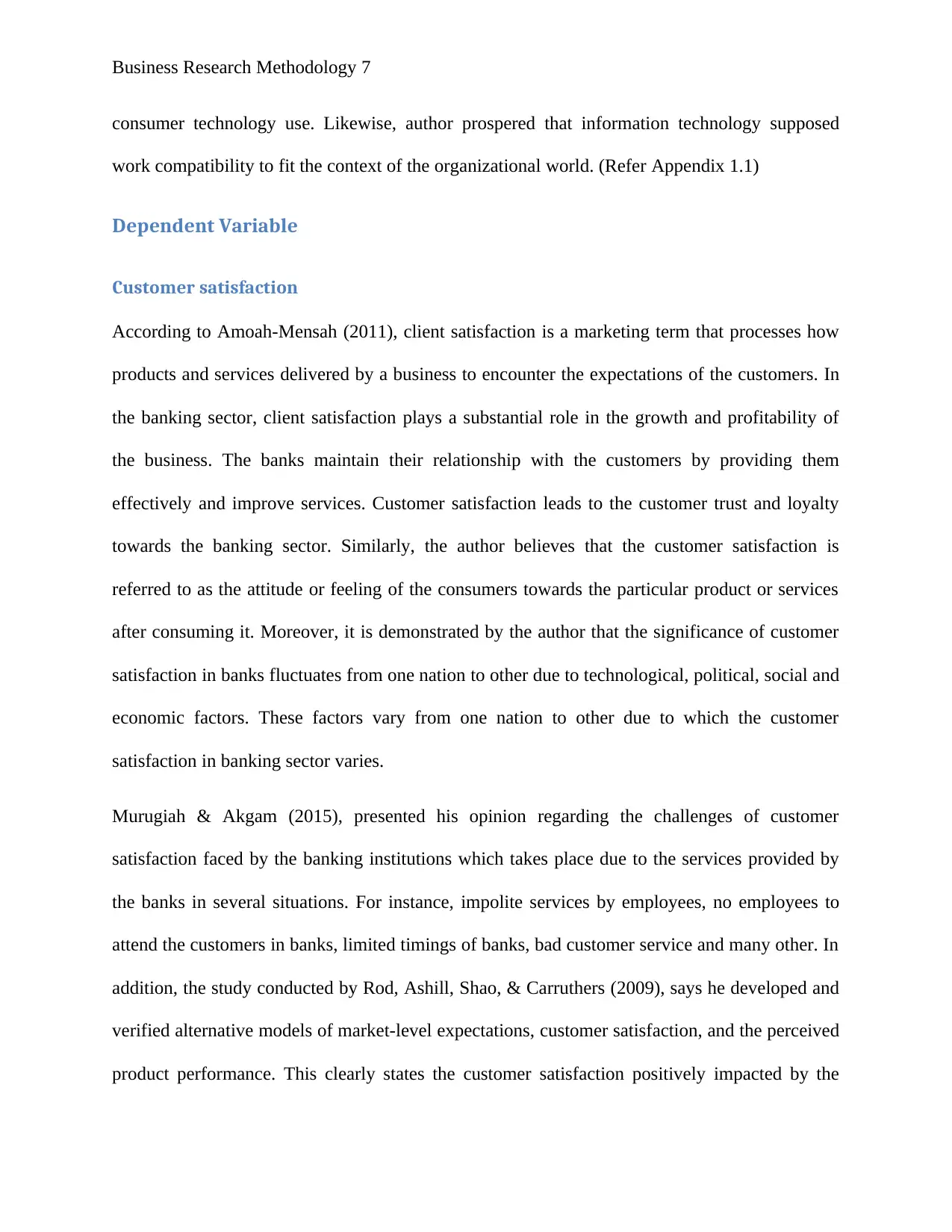
Business Research Methodology 7
consumer technology use. Likewise, author prospered that information technology supposed
work compatibility to fit the context of the organizational world. (Refer Appendix 1.1)
Dependent Variable
Customer satisfaction
According to Amoah-Mensah (2011), client satisfaction is a marketing term that processes how
products and services delivered by a business to encounter the expectations of the customers. In
the banking sector, client satisfaction plays a substantial role in the growth and profitability of
the business. The banks maintain their relationship with the customers by providing them
effectively and improve services. Customer satisfaction leads to the customer trust and loyalty
towards the banking sector. Similarly, the author believes that the customer satisfaction is
referred to as the attitude or feeling of the consumers towards the particular product or services
after consuming it. Moreover, it is demonstrated by the author that the significance of customer
satisfaction in banks fluctuates from one nation to other due to technological, political, social and
economic factors. These factors vary from one nation to other due to which the customer
satisfaction in banking sector varies.
Murugiah & Akgam (2015), presented his opinion regarding the challenges of customer
satisfaction faced by the banking institutions which takes place due to the services provided by
the banks in several situations. For instance, impolite services by employees, no employees to
attend the customers in banks, limited timings of banks, bad customer service and many other. In
addition, the study conducted by Rod, Ashill, Shao, & Carruthers (2009), says he developed and
verified alternative models of market-level expectations, customer satisfaction, and the perceived
product performance. This clearly states the customer satisfaction positively impacted by the
consumer technology use. Likewise, author prospered that information technology supposed
work compatibility to fit the context of the organizational world. (Refer Appendix 1.1)
Dependent Variable
Customer satisfaction
According to Amoah-Mensah (2011), client satisfaction is a marketing term that processes how
products and services delivered by a business to encounter the expectations of the customers. In
the banking sector, client satisfaction plays a substantial role in the growth and profitability of
the business. The banks maintain their relationship with the customers by providing them
effectively and improve services. Customer satisfaction leads to the customer trust and loyalty
towards the banking sector. Similarly, the author believes that the customer satisfaction is
referred to as the attitude or feeling of the consumers towards the particular product or services
after consuming it. Moreover, it is demonstrated by the author that the significance of customer
satisfaction in banks fluctuates from one nation to other due to technological, political, social and
economic factors. These factors vary from one nation to other due to which the customer
satisfaction in banking sector varies.
Murugiah & Akgam (2015), presented his opinion regarding the challenges of customer
satisfaction faced by the banking institutions which takes place due to the services provided by
the banks in several situations. For instance, impolite services by employees, no employees to
attend the customers in banks, limited timings of banks, bad customer service and many other. In
addition, the study conducted by Rod, Ashill, Shao, & Carruthers (2009), says he developed and
verified alternative models of market-level expectations, customer satisfaction, and the perceived
product performance. This clearly states the customer satisfaction positively impacted by the
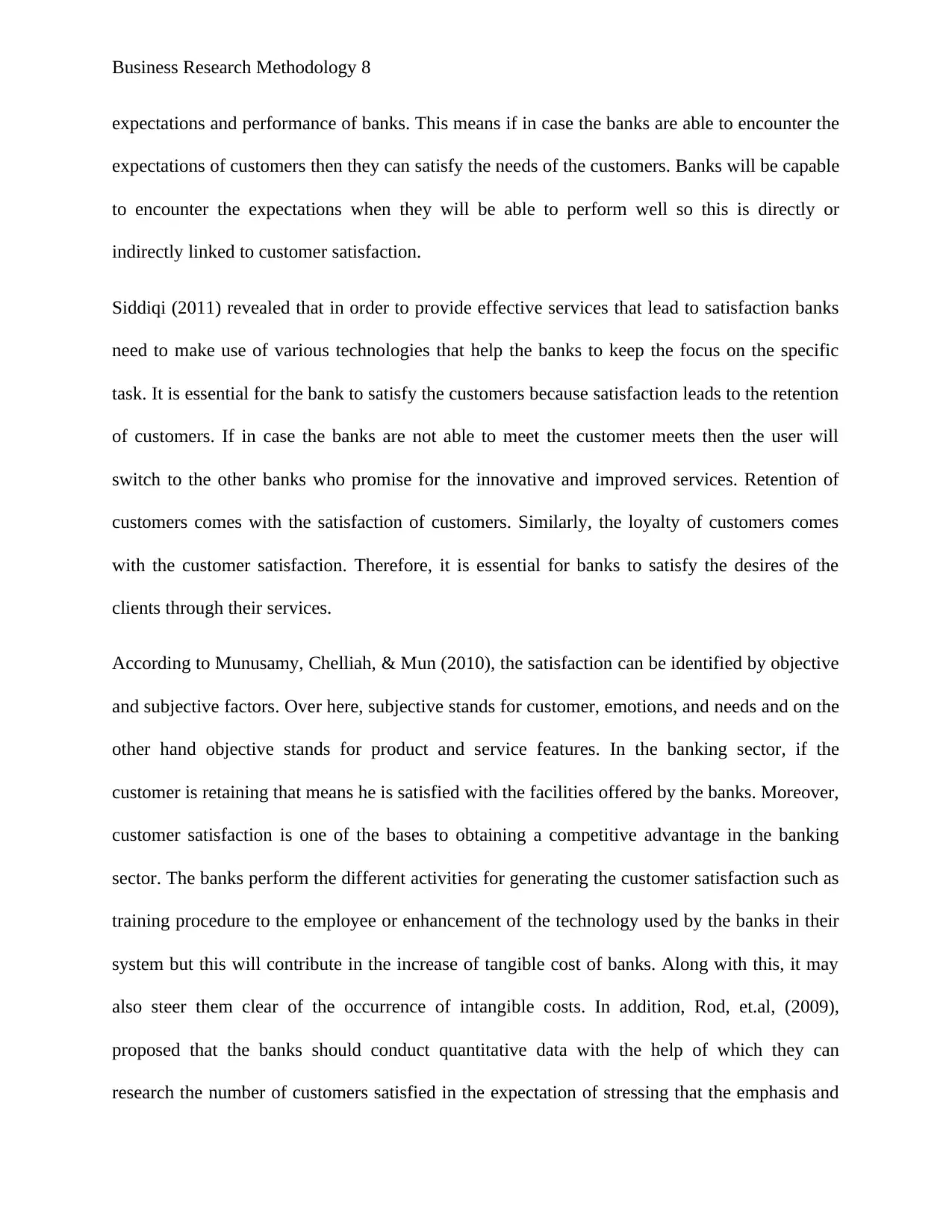
Business Research Methodology 8
expectations and performance of banks. This means if in case the banks are able to encounter the
expectations of customers then they can satisfy the needs of the customers. Banks will be capable
to encounter the expectations when they will be able to perform well so this is directly or
indirectly linked to customer satisfaction.
Siddiqi (2011) revealed that in order to provide effective services that lead to satisfaction banks
need to make use of various technologies that help the banks to keep the focus on the specific
task. It is essential for the bank to satisfy the customers because satisfaction leads to the retention
of customers. If in case the banks are not able to meet the customer meets then the user will
switch to the other banks who promise for the innovative and improved services. Retention of
customers comes with the satisfaction of customers. Similarly, the loyalty of customers comes
with the customer satisfaction. Therefore, it is essential for banks to satisfy the desires of the
clients through their services.
According to Munusamy, Chelliah, & Mun (2010), the satisfaction can be identified by objective
and subjective factors. Over here, subjective stands for customer, emotions, and needs and on the
other hand objective stands for product and service features. In the banking sector, if the
customer is retaining that means he is satisfied with the facilities offered by the banks. Moreover,
customer satisfaction is one of the bases to obtaining a competitive advantage in the banking
sector. The banks perform the different activities for generating the customer satisfaction such as
training procedure to the employee or enhancement of the technology used by the banks in their
system but this will contribute in the increase of tangible cost of banks. Along with this, it may
also steer them clear of the occurrence of intangible costs. In addition, Rod, et.al, (2009),
proposed that the banks should conduct quantitative data with the help of which they can
research the number of customers satisfied in the expectation of stressing that the emphasis and
expectations and performance of banks. This means if in case the banks are able to encounter the
expectations of customers then they can satisfy the needs of the customers. Banks will be capable
to encounter the expectations when they will be able to perform well so this is directly or
indirectly linked to customer satisfaction.
Siddiqi (2011) revealed that in order to provide effective services that lead to satisfaction banks
need to make use of various technologies that help the banks to keep the focus on the specific
task. It is essential for the bank to satisfy the customers because satisfaction leads to the retention
of customers. If in case the banks are not able to meet the customer meets then the user will
switch to the other banks who promise for the innovative and improved services. Retention of
customers comes with the satisfaction of customers. Similarly, the loyalty of customers comes
with the customer satisfaction. Therefore, it is essential for banks to satisfy the desires of the
clients through their services.
According to Munusamy, Chelliah, & Mun (2010), the satisfaction can be identified by objective
and subjective factors. Over here, subjective stands for customer, emotions, and needs and on the
other hand objective stands for product and service features. In the banking sector, if the
customer is retaining that means he is satisfied with the facilities offered by the banks. Moreover,
customer satisfaction is one of the bases to obtaining a competitive advantage in the banking
sector. The banks perform the different activities for generating the customer satisfaction such as
training procedure to the employee or enhancement of the technology used by the banks in their
system but this will contribute in the increase of tangible cost of banks. Along with this, it may
also steer them clear of the occurrence of intangible costs. In addition, Rod, et.al, (2009),
proposed that the banks should conduct quantitative data with the help of which they can
research the number of customers satisfied in the expectation of stressing that the emphasis and
⊘ This is a preview!⊘
Do you want full access?
Subscribe today to unlock all pages.

Trusted by 1+ million students worldwide
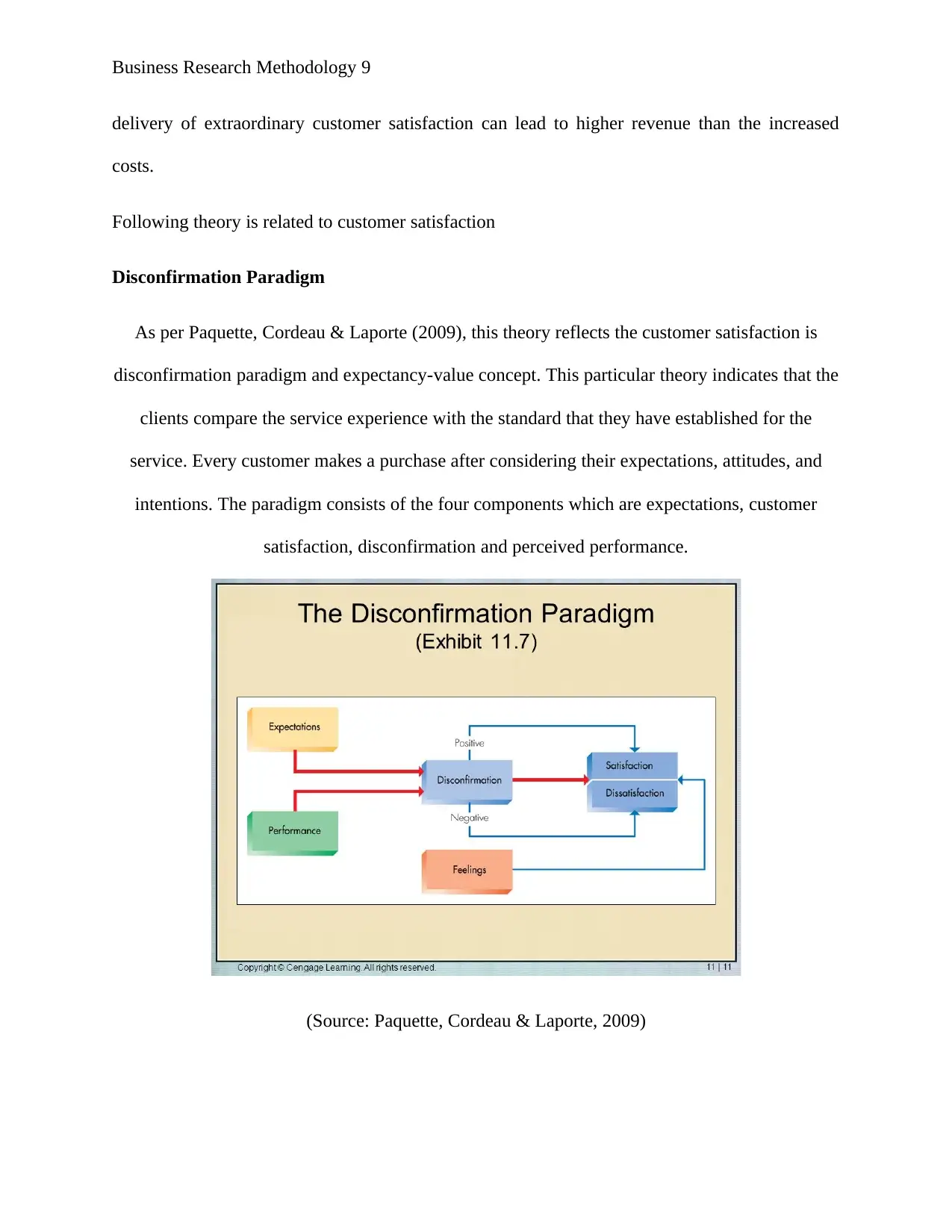
Business Research Methodology 9
delivery of extraordinary customer satisfaction can lead to higher revenue than the increased
costs.
Following theory is related to customer satisfaction
Disconfirmation Paradigm
As per Paquette, Cordeau & Laporte (2009), this theory reflects the customer satisfaction is
disconfirmation paradigm and expectancy-value concept. This particular theory indicates that the
clients compare the service experience with the standard that they have established for the
service. Every customer makes a purchase after considering their expectations, attitudes, and
intentions. The paradigm consists of the four components which are expectations, customer
satisfaction, disconfirmation and perceived performance.
(Source: Paquette, Cordeau & Laporte, 2009)
delivery of extraordinary customer satisfaction can lead to higher revenue than the increased
costs.
Following theory is related to customer satisfaction
Disconfirmation Paradigm
As per Paquette, Cordeau & Laporte (2009), this theory reflects the customer satisfaction is
disconfirmation paradigm and expectancy-value concept. This particular theory indicates that the
clients compare the service experience with the standard that they have established for the
service. Every customer makes a purchase after considering their expectations, attitudes, and
intentions. The paradigm consists of the four components which are expectations, customer
satisfaction, disconfirmation and perceived performance.
(Source: Paquette, Cordeau & Laporte, 2009)
Paraphrase This Document
Need a fresh take? Get an instant paraphrase of this document with our AI Paraphraser
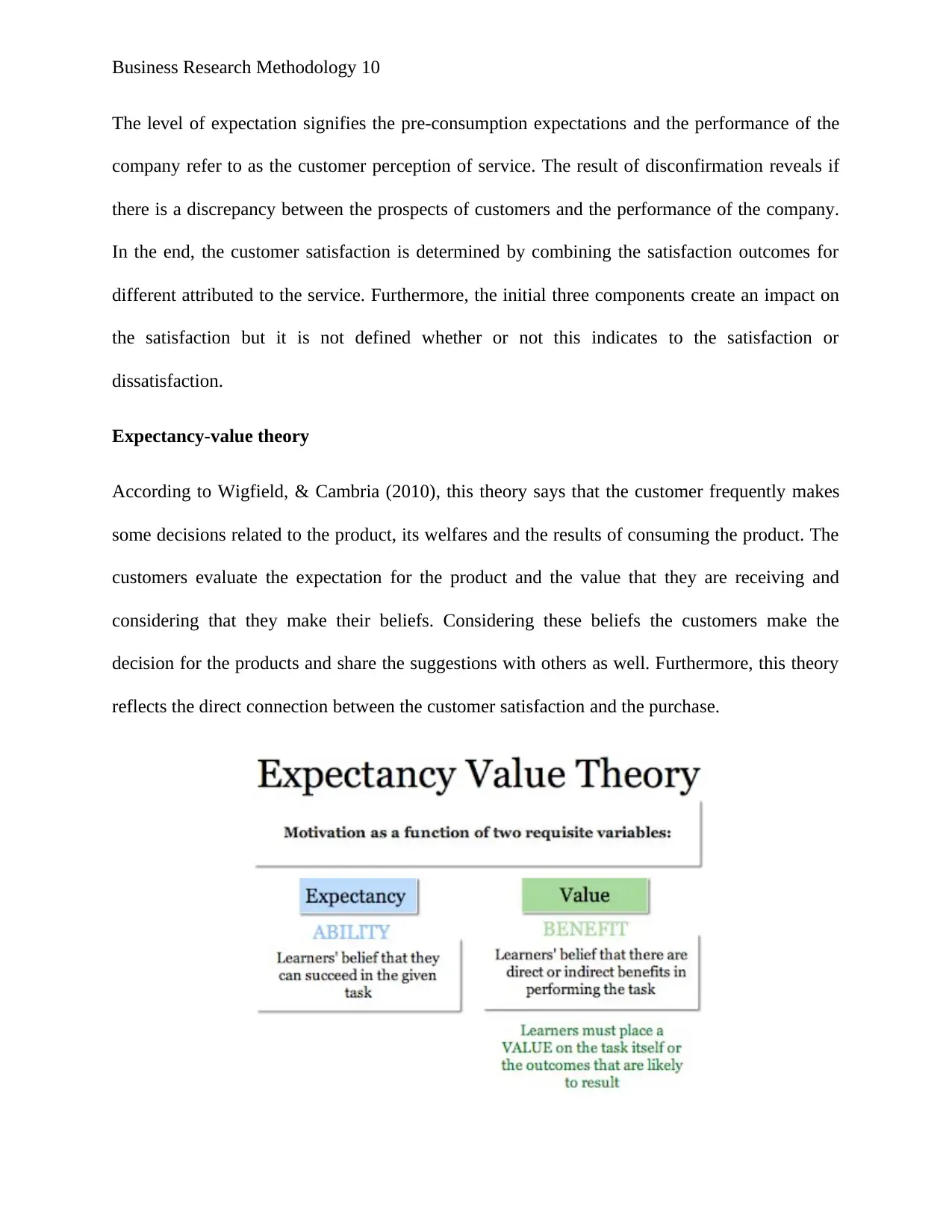
Business Research Methodology 10
The level of expectation signifies the pre-consumption expectations and the performance of the
company refer to as the customer perception of service. The result of disconfirmation reveals if
there is a discrepancy between the prospects of customers and the performance of the company.
In the end, the customer satisfaction is determined by combining the satisfaction outcomes for
different attributed to the service. Furthermore, the initial three components create an impact on
the satisfaction but it is not defined whether or not this indicates to the satisfaction or
dissatisfaction.
Expectancy-value theory
According to Wigfield, & Cambria (2010), this theory says that the customer frequently makes
some decisions related to the product, its welfares and the results of consuming the product. The
customers evaluate the expectation for the product and the value that they are receiving and
considering that they make their beliefs. Considering these beliefs the customers make the
decision for the products and share the suggestions with others as well. Furthermore, this theory
reflects the direct connection between the customer satisfaction and the purchase.
The level of expectation signifies the pre-consumption expectations and the performance of the
company refer to as the customer perception of service. The result of disconfirmation reveals if
there is a discrepancy between the prospects of customers and the performance of the company.
In the end, the customer satisfaction is determined by combining the satisfaction outcomes for
different attributed to the service. Furthermore, the initial three components create an impact on
the satisfaction but it is not defined whether or not this indicates to the satisfaction or
dissatisfaction.
Expectancy-value theory
According to Wigfield, & Cambria (2010), this theory says that the customer frequently makes
some decisions related to the product, its welfares and the results of consuming the product. The
customers evaluate the expectation for the product and the value that they are receiving and
considering that they make their beliefs. Considering these beliefs the customers make the
decision for the products and share the suggestions with others as well. Furthermore, this theory
reflects the direct connection between the customer satisfaction and the purchase.
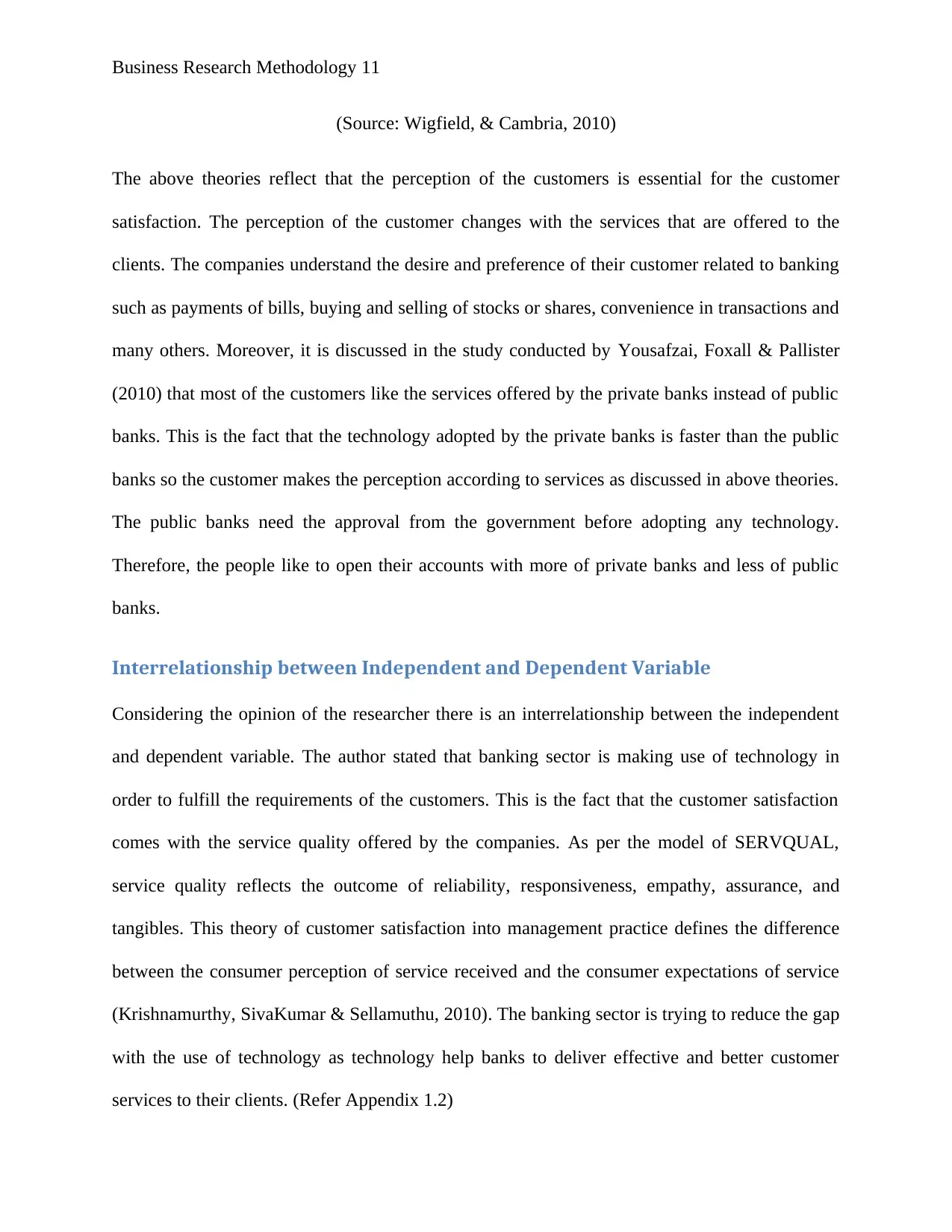
Business Research Methodology 11
(Source: Wigfield, & Cambria, 2010)
The above theories reflect that the perception of the customers is essential for the customer
satisfaction. The perception of the customer changes with the services that are offered to the
clients. The companies understand the desire and preference of their customer related to banking
such as payments of bills, buying and selling of stocks or shares, convenience in transactions and
many others. Moreover, it is discussed in the study conducted by Yousafzai, Foxall & Pallister
(2010) that most of the customers like the services offered by the private banks instead of public
banks. This is the fact that the technology adopted by the private banks is faster than the public
banks so the customer makes the perception according to services as discussed in above theories.
The public banks need the approval from the government before adopting any technology.
Therefore, the people like to open their accounts with more of private banks and less of public
banks.
Interrelationship between Independent and Dependent Variable
Considering the opinion of the researcher there is an interrelationship between the independent
and dependent variable. The author stated that banking sector is making use of technology in
order to fulfill the requirements of the customers. This is the fact that the customer satisfaction
comes with the service quality offered by the companies. As per the model of SERVQUAL,
service quality reflects the outcome of reliability, responsiveness, empathy, assurance, and
tangibles. This theory of customer satisfaction into management practice defines the difference
between the consumer perception of service received and the consumer expectations of service
(Krishnamurthy, SivaKumar & Sellamuthu, 2010). The banking sector is trying to reduce the gap
with the use of technology as technology help banks to deliver effective and better customer
services to their clients. (Refer Appendix 1.2)
(Source: Wigfield, & Cambria, 2010)
The above theories reflect that the perception of the customers is essential for the customer
satisfaction. The perception of the customer changes with the services that are offered to the
clients. The companies understand the desire and preference of their customer related to banking
such as payments of bills, buying and selling of stocks or shares, convenience in transactions and
many others. Moreover, it is discussed in the study conducted by Yousafzai, Foxall & Pallister
(2010) that most of the customers like the services offered by the private banks instead of public
banks. This is the fact that the technology adopted by the private banks is faster than the public
banks so the customer makes the perception according to services as discussed in above theories.
The public banks need the approval from the government before adopting any technology.
Therefore, the people like to open their accounts with more of private banks and less of public
banks.
Interrelationship between Independent and Dependent Variable
Considering the opinion of the researcher there is an interrelationship between the independent
and dependent variable. The author stated that banking sector is making use of technology in
order to fulfill the requirements of the customers. This is the fact that the customer satisfaction
comes with the service quality offered by the companies. As per the model of SERVQUAL,
service quality reflects the outcome of reliability, responsiveness, empathy, assurance, and
tangibles. This theory of customer satisfaction into management practice defines the difference
between the consumer perception of service received and the consumer expectations of service
(Krishnamurthy, SivaKumar & Sellamuthu, 2010). The banking sector is trying to reduce the gap
with the use of technology as technology help banks to deliver effective and better customer
services to their clients. (Refer Appendix 1.2)
⊘ This is a preview!⊘
Do you want full access?
Subscribe today to unlock all pages.

Trusted by 1+ million students worldwide
1 out of 21
Related Documents
Your All-in-One AI-Powered Toolkit for Academic Success.
+13062052269
info@desklib.com
Available 24*7 on WhatsApp / Email
![[object Object]](/_next/static/media/star-bottom.7253800d.svg)
Unlock your academic potential
Copyright © 2020–2025 A2Z Services. All Rights Reserved. Developed and managed by ZUCOL.





